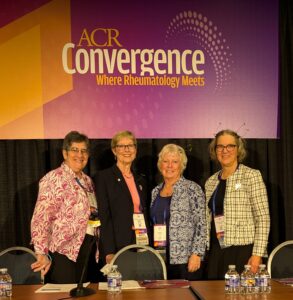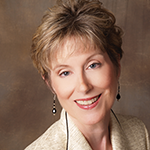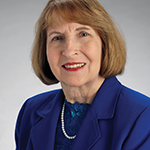
Co-presenters led the Reflections on Past, Present and Future Opportunities for Rheumatology Health Professionals session at ACR Convergence 2024. (Click to enlarge.)
ACR Convergence 2024—In a wide-ranging and engaging discussion, members of the Association of Rheumatology Professionals (ARP) tracked their progress over the years across clinical practice, research production and representation in the field, while outlining challenges and opportunities to come.
The session at ACR Convergence included a panel and an audience full of past presidents of the ARP—there were 15 past presidents in attendance, by one count—and highlighted the strides the field has made since 1970s and 1980s. To symbolize this past growth and stimulate future personal, professional and organizational growth, the session leaders distributed pins in the form of green sprouts for attendees to attach to their badges or lapels.
“We thought it’s important to look back in order to look forward with thoughtful purpose,” said Marian Hannan, DSc, MPH, professor of epidemiology at Harvard Medical School and president of the ARP in 1998–1999.
When panelists and audience members started to track the changes seen in the field—most of which they’ve presided over and helped to bring about—some of these advances struck them as dramatic.
Back in the 1960s and 1970s, patients were told to get ample bed rest and be careful with their movements, said session panelist Teresa Brady, PhD, an occupational therapist and psychologist and ARP president in 1991.
“We didn’t actually stress them at all,” she said. “Now, of course, we’re doing resistive exercise, aerobic exercise. We’ve changed our approach to exercise completely.”
Kam Nola, PharmD, MS, a pharmacist in Nashville who was in the audience, said it has been nice to see the advances in treatments from simply prescribing high-dose aspirin to, now, targeted therapies.
“It’s really cool to see the evolution,” she said.
Christine Stamatos, DNP, ANP-C, a nurse practitioner in audience noted, though, that, “In the era of treatments we have, we’ve stopped using [physical therapists] and [occupational therapists] and I think we’re doing [patients] a huge disservice. And I think we need to go back and recognize the value of my PT and OT friends. I refer to OT all the time for my patients who just can’t get themselves together, who need to improve their quality of life, who need to engage in life better, and I learned that through being involved in this organization. Prior to that I had no idea what an OT did. I thought all they did was hands.”



